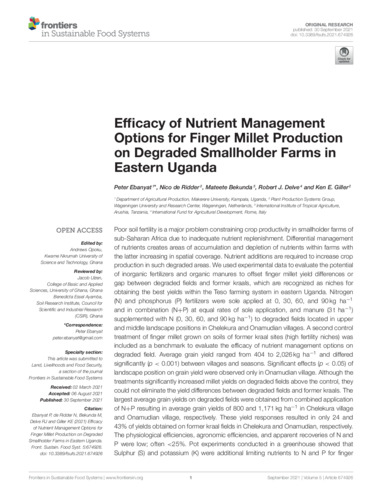Efficacy of nutrient management options for finger millet production on degraded smallholder farms in eastern Uganda
Abstract
Poor soil fertility is a major problem constraining crop productivity in smallholder farms of sub-Saharan Africa due to inadequate nutrient replenishment. Differential management of nutrients creates areas of accumulation and depletion of nutrients within farms with the latter increasing in spatial coverage. Nutrient additions are required to increase crop production in such degraded areas. We used experimental data to evaluate the potential of inorganic fertilizers and organic manures to offset finger millet yield differences or gap between degraded fields and former kraals, which are recognized as niches for obtaining the best yields within the Teso farming system in eastern Uganda. Nitrogen (N) and phosphorus (P) fertilizers were sole applied at 0, 30, 60, and 90 kg ha−1 and in combination (N+P) at equal rates of sole application, and manure (3 t ha−1) supplemented with N (0, 30, 60, and 90 kg ha−1) to degraded fields located in upper and middle landscape positions in Chelekura and Onamudian villages. A second control treatment of finger millet grown on soils of former kraal sites (high fertility niches) was included as a benchmark to evaluate the efficacy of nutrient management options on degraded field. Average grain yield ranged from 404 to 2,026 kg ha−1 and differed
significantly (p < 0.001) between villages and seasons. Significant effects (p < 0.05) of landscape position on grain yield were observed only in Onamudian village. Although the treatments significantly increased millet yields on degraded fields above the control, they could not eliminate the yield differences between degraded fields and former kraals. The largest average grain yields on degraded fields were obtained from combined application of N+P resulting in average grain yields of 800 and 1,171 kg ha−1 in Chelekura village and Onamudian village, respectively. These yield responses resulted in only 24 and 43% of yields obtained on former kraal fields in Chelekura and Onamudian, respectively.
The physiological efficiencies, agronomic efficiencies, and apparent recoveries of N and P were low; often <25%. Pot experiments conducted in a greenhouse showed that Sulphur (S) and potassium (K) were additional limiting nutrients to N and P for finger millet production in Chelekura and Onamudian and may partly explain the large yield differences of finger millet between fertilized fields and former kraals in the smallholder
farming systems. Nutrient management strategies for sustainable millet production in these farming systems need consideration of site-specific nutrient limitations.

